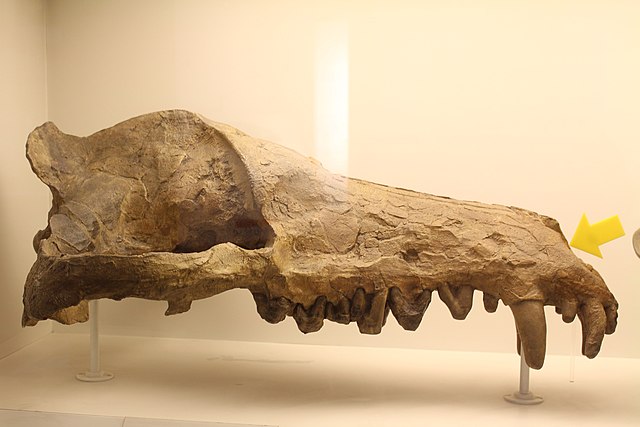Andrewsarchus is indeed a mysterious and enigmatic creature, and much of what is known about it comes from fragmentary fossils, leading to ongoing debates and uncertainties about its exact classification and lifestyle. Here are some key points about Andrewsarchus:
1. Taxonomy and Classification:
- Genus: Andrewsarchus.
- Classification: Andrewsarchus is often classified within the family Mesonychidae, an extinct group of carnivorous mammals. However, due to incomplete fossils, its exact taxonomic placement is still debated.

2. Size and Appearance:
- Size: Andrewsarchus is considered one of the largest terrestrial mammals to have ever lived. Estimates suggest it was about the size of a large rhinoceros.
- Physical Features: Based on limited fossil evidence, it’s believed to have had a large head and robust jaws.
3. Fossil Discovery:
- Location: Fossils of Andrewsarchus have been found in Mongolia.
- Geological Age: It lived during the late Eocene, approximately 45 to 36 million years ago.
4. Debates and Uncertainties:
- Incomplete Fossils: The available fossils are fragmentary, consisting mainly of a large skull and a few other bones, making it challenging to reconstruct the entire animal accurately.
- Controversies: There is ongoing scientific debate about whether Andrewsarchus was a mesonychid or part of another group, and even its exact lifestyle and ecological role are not well-established.
5. Ecological Role and Lifestyle:
- Carnivorous Diet: It is generally inferred to have been a carnivore, but the specifics of its diet and hunting behaviors are uncertain.
- Habitat: Andrewsarchus likely inhabited the forested regions of ancient Mongolia.
6. Relation to Other Mammals:
- Mesonychids: If it is indeed a mesonychid, Andrewsarchus would be related to other hoofed predators of its time, but it also shows some characteristics that make its classification challenging.
7. Cultural Significance:
- Popularity in Paleontology: Despite its mysterious nature, Andrewsarchus is well-known and often discussed in paleontological circles due to its size and the uncertainties surrounding its classification.
8. Scientific Methodology:
- Advancements in Technology: Advances in technology, such as CT scans and digital modeling, have allowed scientists to study and analyze the available fossils in greater detail, leading to ongoing refinements in our understanding.
9. Educational Value:
- Teaching Tool: Andrewsarchus serves as an educational case study in paleontology, highlighting the challenges of reconstructing the biology of extinct species based on incomplete fossil evidence.
Andrewsarchus remains a mysterious and intriguing figure in the fossil record, emphasizing the complexities of paleontological research and the challenges of reconstructing the past with limited evidence. As technology and research methods advance, our understanding of enigmatic creatures like Andrewsarchus may continue to evolve.











